They were often referred to as the 'Flying Brick'. Some pilots joked that it didn't matter whether you were flying sideways or straight ahead, the handling was equally bad. Another common one was that the F-4 was proof that a brick could fly given enough thrust.
McDonnell had to pull a lot of rabbits out of the hat during the design and development stage to get it to fly, with the help of BuAer's input as well. Some of the main concerns were roll coupling, pitch up at supersonic speeds, low speed stability and the spin characteristics.
They designed 75 different wings and found only one resisted pitch up, hence the saw tooth on the outer leading edge. Part of the roll stability was to be provided by a six degree wing dihedral, but when the airframe was reviewed it was found to have negative dihedral due to the design of the main spar. By this stage the wing spar was already committed to production, so the outer wing was cranked up twelve degrees to give the whole wing an effective three degrees dihedral. Another method to control roll was the use of an automatic stability augmentation system to dampen aileron and rudder input. The twenty three degree anhedral on the tail complimented the wing to provide more roll stability.
Low speed stability issues were adressed by the addition of a boundary layer control system with ducted air to the leading edge and trailing edge wing flaps. The ducts terminated in slots which were blocked off by the flaps in the up position. Lowering the flaps exposed the slots and via a mechanical linkage from the flaps, actuated the valves to allow hot pressurized air from the compressor to flow over the wing and flaps, delaying flow separation. The use of BLC was mainly due to it being primarily a Naval aircraft. The Navy influence carried on right through production, an example being that all F-4's built had folding wings.
A fair amount of the design process seemed to be a bit of cut and paste. Aerodynamically, it really is a brick with just enough gadgets attached to make it fly. They say it still has to be treated with a lot of respect, particularly in regard to adverse yaw getting out of control.
Cheers, Willie.






